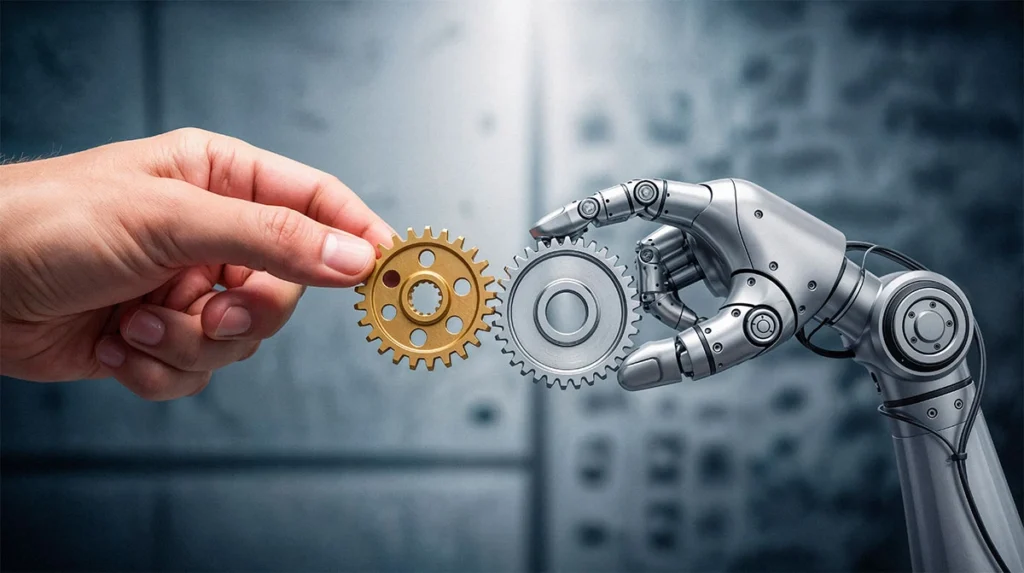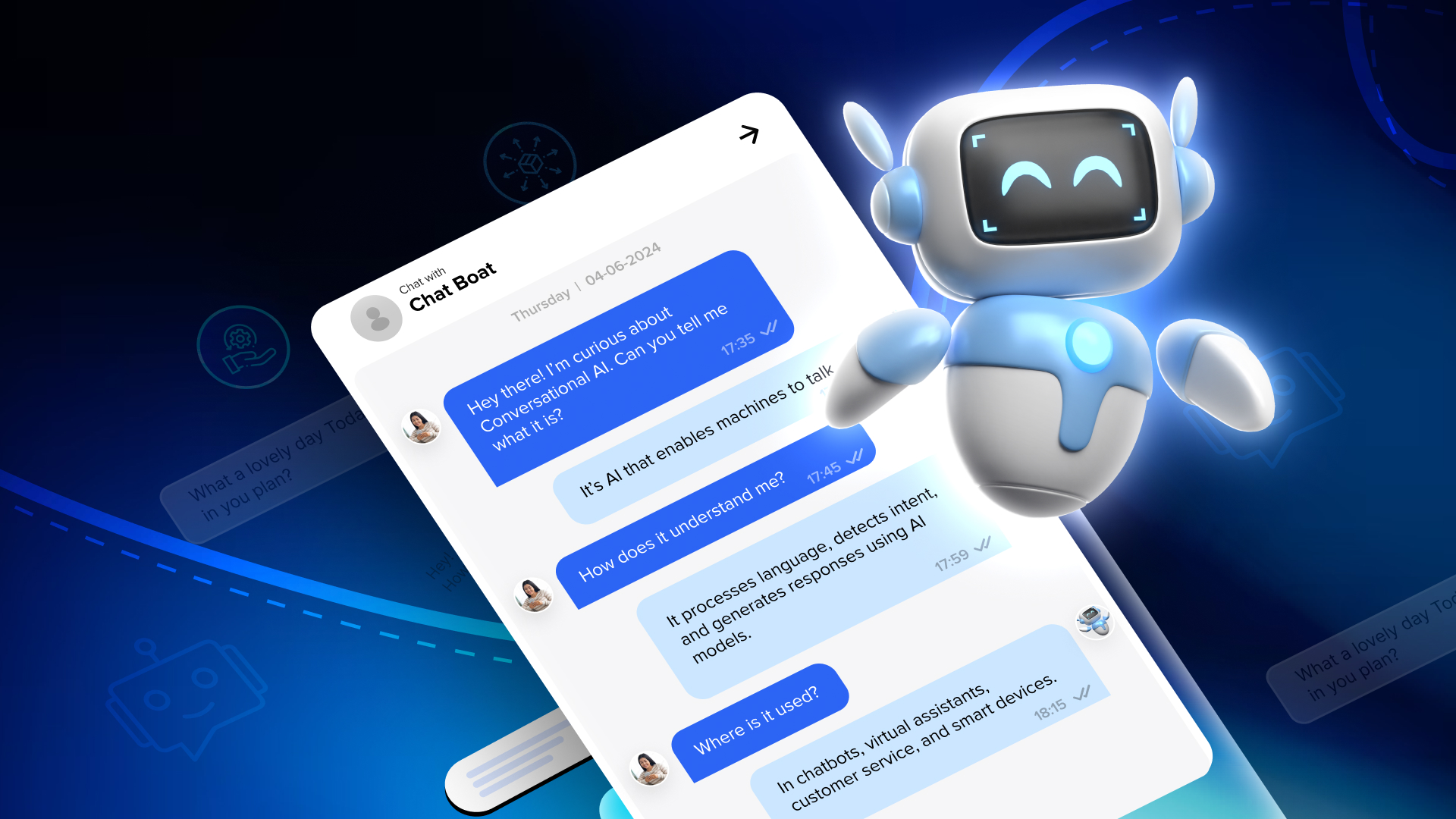Managing contracts has felt like solving a puzzle in the dark for far too long. It’s a process defined by fragmented emails, scattered spreadsheets, and endless document versions saved in different folders. From initial drafting to final renewal, the contract lifecycle is a tangled web of manual tasks, bottlenecks, and a significant margin for human error.
This manual chaos doesn’t just slow down business; it introduces serious risks, erodes trust, and prevents teams from focusing on strategic, high-value work. The traditional method of doing things is outdated. However, a new paradigm is emerging: artificial intelligence transforms this chaotic workflow into a model of automated precision.
AI workflow management fundamentally rethinks how we manage contracts, offering more than a new tool. It’s about creating a seamless, intelligent flow where tasks are automated and performed with a contextual understanding that mirrors human expertise powered by advanced AI machine learning services that enhance efficiency, accuracy, and decision-making throughout the contract lifecycle.
It shifts contracting from a series of disjointed, reactive steps to a single, proactive, and perfectly orchestrated journey. Let’s explore how this powerful technology redefines the entire contract lifecycle and liberates businesses from manual labor.
The Invisible Wall: The Chaos of Manual Contracting
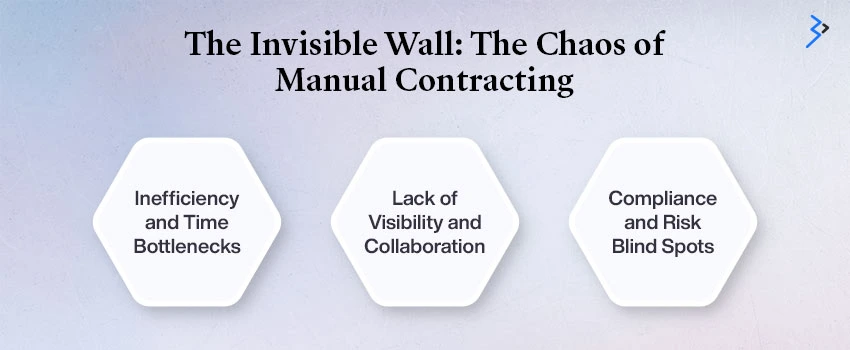
To appreciate AI’s power, you must first understand the pain points it addresses. Traditional contract workflows encounter significant, often hidden, challenges that create an invisible wall around your business processes.
- Inefficiency and Time Bottlenecks: Manual contract review and approval can feel like running in slow motion. Teams spend countless hours reading, redlining, and cross-checking documents. A survey conducted by ContractPodAi shows that legal teams spend up to 70% of their time on manual, repetitive tasks. Delays are a domino effect, slowing sales cycles, hindering vendor onboarding, and frustrating stakeholders waiting for a green light.
- Lack of Visibility and Collaboration: In a manual process, it’s nearly impossible to know the real-time status of a contract. Where is the document in the approval queue? Whose desk is it on? Version control is a nightmare, with different teams working on outdated drafts, leading to miscommunication and potential disputes.

- Compliance and Risk Blind Spots: Manual reviews are inherently prone to human error. A single overlooked clause, a missed deadline, or an inconsistent term across agreements can have serious financial and legal consequences. As the regulatory landscape evolves, staying compliant becomes a monumental task. The risk of non-compliance due to a manual misstep is a silent liability that can explode into a major crisis.
These challenges affect more than just the legal department; they permeate the entire organization, costing businesses an average of 9% of their annual revenue due to inefficient contract management.
The Core of the Revolution: What is AI Workflow Management?
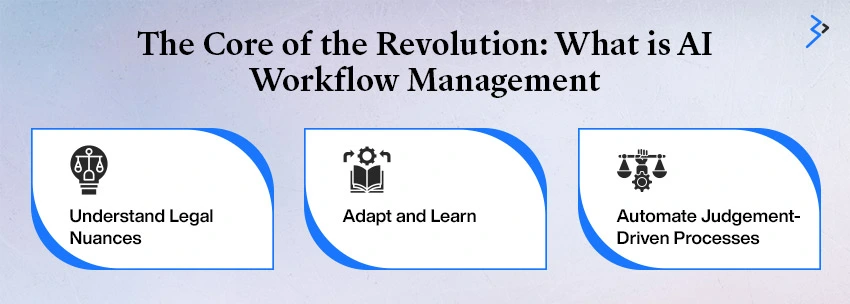
At its heart, AI workflow management is about moving beyond simple automation. Traditional automation tools, like basic rule-based systems, are good at following fixed instructions. They can, for example, route a document based on a pre-defined rule (“If value > $50K, send to CFO”).
Generative AI development services, however, is a different beast. Large language models power this technology, enabling it to understand context and make judgment-based decisions. The capability is key to redefining contracts.
AI workflow management leverages this intelligence work managment to create dynamic, end-to-end workflows. It can:
- Understand Legal Nuances: The AI can comprehend the meaning and intent behind a clause, not just spot keywords. It can identify a “risky” clause based on its legal implications, not just a simple search term.
- Adapt and Learn: The system learns from your organization’s historical data and successful outcomes. Over time, it can make increasingly accurate decisions and recommendations, such as suggesting the best legal language for a specific situation.
- Automate Judgement-Driven Processes: This is the most powerful capability. Instead of routing a document, AI can automatically approve a low-risk, standard contract without human intervention, flagging only those requiring expert review. It allows your team to focus on the exceptions, not the rules.
This fundamental shift empowers legal and business professionals to act as strategic advisors rather than administrative gatekeepers.
Read More – How Generative AI Is Revolutionizing Contract Review: Faster Approvals, Lower Risk
The Blueprint for Precision: How AI Transforms Each Stage of the Contract Lifecycle
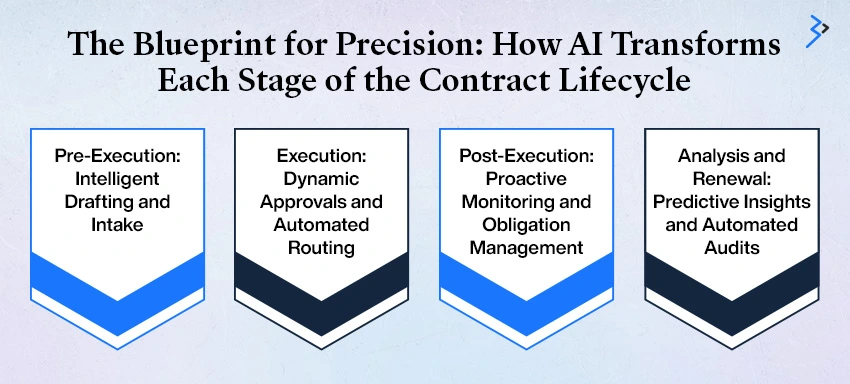
The power of AI lies in its ability to bring precision and intelligence to every single stage of the contract lifecycle.
1. Pre-Execution: Intelligent Drafting and Intake
Chaos often begins at the very beginning. With AI, a request for a new contract isn’t just a document. A business user can outline their needs, and the AI can draft an initial contract template based on the company’s approved legal playbook and standard clauses.
For example, a sales rep can input the customer name, deal value, and key terms into a simple form, and the AI instantly generates a compliant contract draft. This capability dramatically cuts down on drafting time. It ensures that every new contract is built on a foundation of best practices, preventing errors and ensuring consistency.
2. Execution: Dynamic Approvals and Automated Routing
The traditional approval process is a significant bottleneck. AI workflow management turns this on its head. It dynamically routes a contract to the right people based on many factors, not just a single rule. It can consider the contract type, value, risk score, and even its specific clauses.
- Smart Approvals: If the AI determines a low-risk contract and uses all standard clauses, it can automatically approve it, eliminating the need for manual review.
- Parallel Review: The AI can send a document to multiple stakeholders (e.g., legal, finance, sales) simultaneously, accelerating the review process and providing a single, collaborative platform for comments and redlines.
- Automated Reminders and Escalations: The system tracks every stage of the approval process and sends computerized reminders. If a review experiences a delay, the system automatically escalates the request to facilitate a smooth continuation of the deal.
According to Gainfront, an innovative approach reduces contract cycle times by up to 73%, enabling businesses to adapt quickly to market changes.
3. Post-Execution: Proactive Monitoring and Obligation Management
A contract’s signature is not the finish line; it’s the starting block. In this context, the actual value of AI in risk management becomes clear. Once parties execute an agreement, AI continuously monitors it to ensure compliance and performance.
- Automated Obligation Extraction: The AI automatically extracts key obligations, dates, and terms from the contract and populates them into a centralized dashboard. It generates alerts for upcoming deadlines, ensuring you don’t miss renewal, payment, or delivery dates.
- Continuous Compliance Checks: As new regulations emerge, the AI scans your entire contract portfolio and flags any agreements needing updating. This proactive monitoring ensures you are always ahead of the compliance curve, reducing the risk of penalties.
- Performance Monitoring: AI can be integrated with various business systems, such as ERP and CRM development services, to meet contractual obligations. The integration offers real-time insights into your business relationships.
4. Analysis and Renewal: Predictive Insights and Automated Audits
AI turns your contract data from a static library into a strategic asset. AI analyzes patterns across thousands of contracts and provides predictive insights that inform future decisions.
- Strategic Negotiation: AI can analyze past negotiation outcomes and provide data-backed insights on which clauses are most likely to be accepted by a counterparty, giving your negotiators a competitive edge.
- Automated Audits: Instead of a lengthy and costly manual audit, AI can generate comprehensive reports on contract terms, compliance, and performance in minutes, ensuring you are always audit-ready.
According to research from Deloitte, organizations adopting AI for legal tasks can expect to see reductions in legal spend by 10-20% through improved efficiency and risk mitigation.
Read More – From Manual to Intelligent: How AI and RPA Are Redefining Customer Support
Overcoming the Hurdles: Making the Transition to AI-Powered Workflows
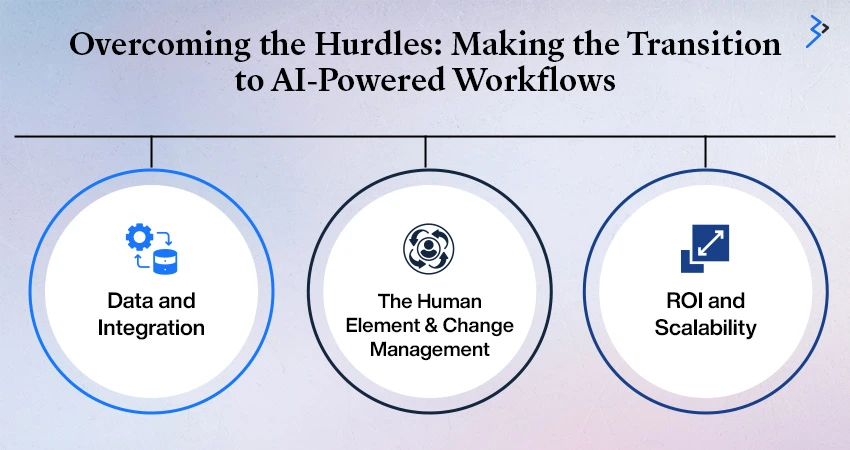
While AI’s promise is clear, transitioning from manual chaos to automated precision requires a thoughtful approach.
- Data and Integration: AI is only as effective as the data it’s trained on. The first step is ensuring a clean, organized, secure contract repository. The solution must also integrate seamlessly with your existing tech stack (e.g., Salesforce, SAP) to create a unified workflow.
- The Human Element and Change Management: The most significant challenge isn’t the technology itself but the people who use it. Legal professionals are moving from manual review to strategic oversight. A cultural shift and a detailed plan for training and upskilling teams to collaborate effectively with their new AI co-pilot are necessary.
- ROI and Scalability: AI’s ROI is not always immediate. While initial gains in efficiency are quick, the actual value, in the form of risk reduction and strategic insights, compounds over time. A report from IBM found that 53% of organizations already see a return on their AI investments, proving that the long-term benefits are well worth the investment.
Conclusion: Partnering for a Smarter Future
The era of manual, fragmented contract management is over. In its place is a new paradigm of AI workflow management that brings unparalleled precision, speed, and strategic insight to every stage of the contract lifecycle. The transition involves not just using a new tool; it’s about reimagining how business operates, shifting from a reactive stance to a proactive approach.
At Brainvire, we recognize that every organization faces distinct workflows and challenges.
Our expertise lies in crafting a detailed roadmap for integrating AI, prioritizing data security, and customizing solutions to align with your unique business requirements.
We facilitate a smooth transition from manual inefficiencies to automated accuracy, transforming your contract process from a challenge into a significant competitive edge. The future of contracting goes beyond simply incorporating innovative technology; it revolves around enhancing workflows with greater intelligence.
FAQs:-
Traditional tools follow fixed rules, like routing contracts based on dollar value, while AI workflow management understands context. It can evaluate risk, identify clause intent, and even approve standard low-risk contracts automatically, freeing up legal teams to focus only on exceptions.
Yes. AI powered by large language models can go beyond keyword spotting. It interprets the meaning and intent of clauses, flags risky language, and learns from past negotiations to suggest stronger, more compliant terms tailored to your organization’s playbook.
Absolutely. AI doesn’t stop at signatures. It proactively monitors obligations, deadlines, renewals, and compliance updates. It acts like a 24/7 watchdog, ensuring no commitment slips through the cracks and protecting businesses from penalties or missed opportunities.
Related Articles
-
Creating a Simple Chatbot: Shaping the Future of Conversational AI
We have seen a tremendous shift in artificial intelligence in the last several years, especially in conversational bots. Thanks to advancements in Large Language Models (LLMs), Conversational AI has emerged,
-
NLP Solution Use-Cases Redefining the Business Sector
Natural Language Processing or NLP, as it commonly called, is gaining a lot of momentum these days. Organizations are using this piece of technology in various manners depending upon the
-
Learn How the Beauty Industry Is Getting a Makeover With Artificial Intelligence
Artificial intelligence is extensively used to enhance all the sectors whether it is education, marketing or beauty, the list is endless. And seeing the scope of improvement that can be

